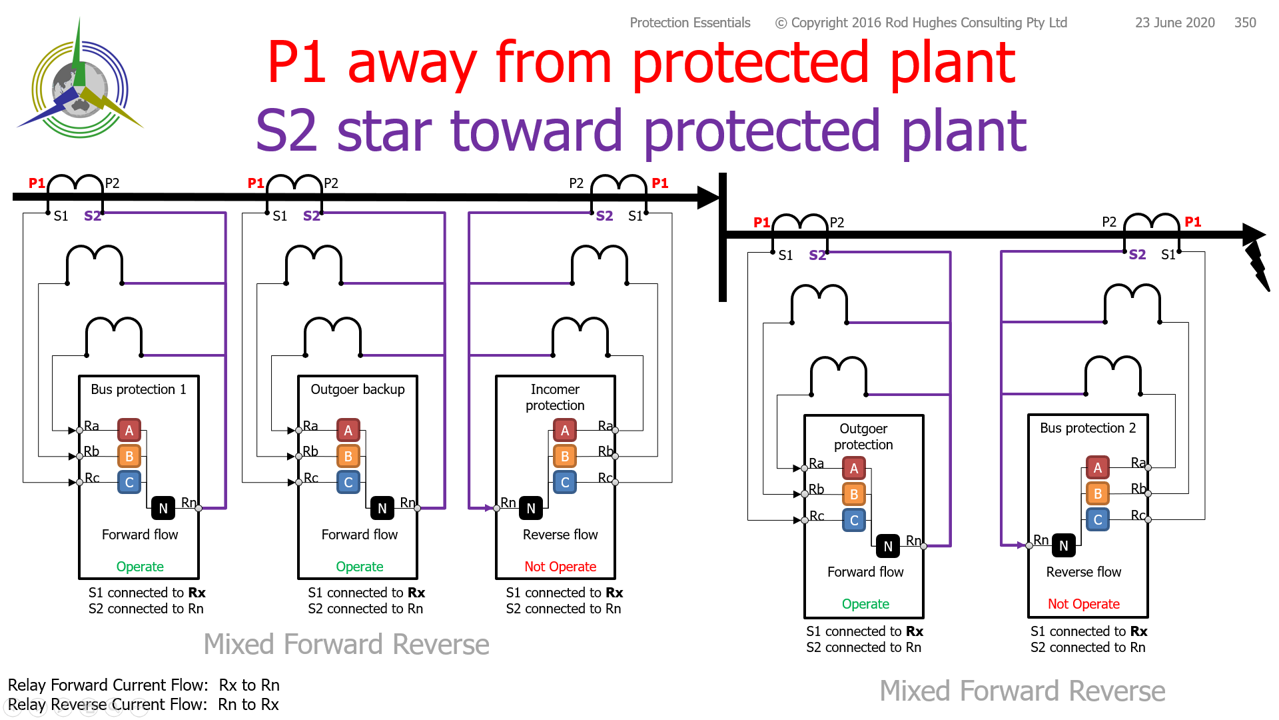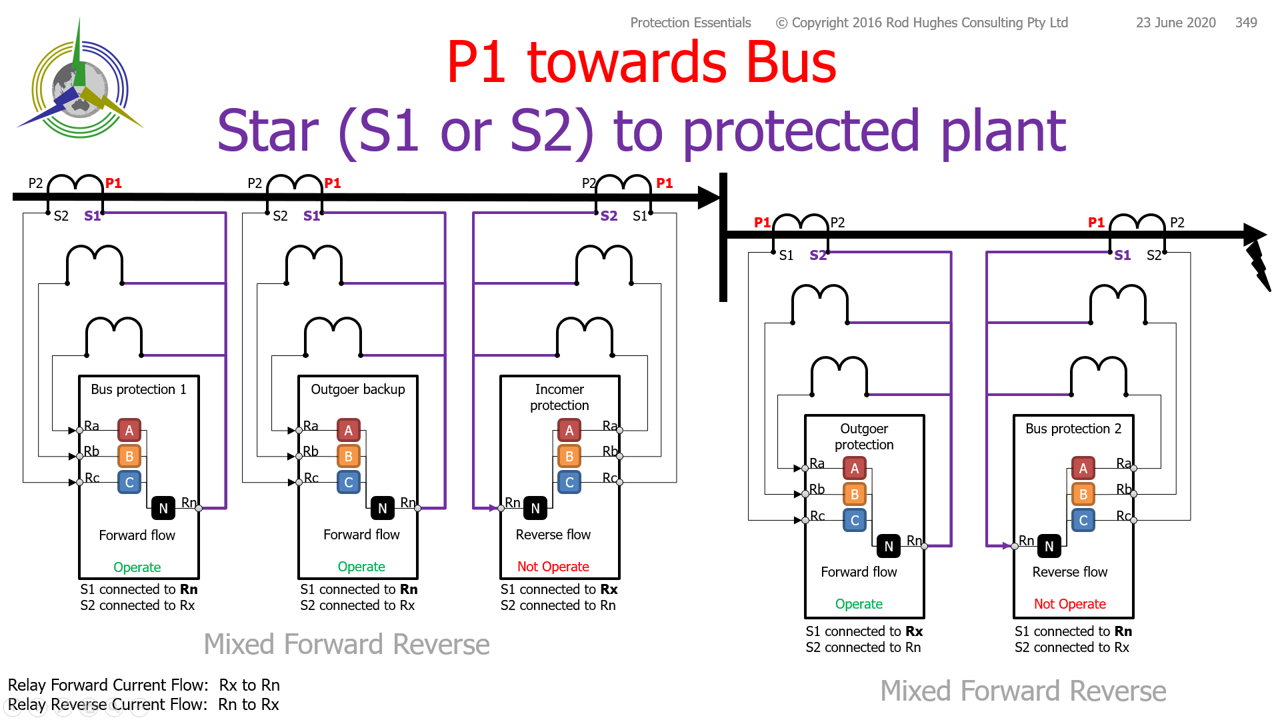| Rod Hughes Consulting General Web Site | Applications Home | Innovations and Solutions Home | A bit about Rod Hughes |
|
|---|
Note - if the navigation pane on the left of this window is not visible, click the 2-pane icon on the top bar
The following diagrams show the effect of three different CT polarity and star side policies used by Australian utilities as applied to a incomer and outgoer of a busbar and a fault on the outgoer.
These three policies are in use by different utilities across Australia.
They are all "correct" i.e. they work!
i.e. all protections looking towards the fault will operate, whilst all protections looking to the left source will not operate .... provided you have set the correct operate direction for the relay.
In some cases operate is for reverse power flow as far as the relay is concerned.
However it is essential you know which policy is in use for the substation you are designing/visiting/testing.
Please note the diagrams carefully .. the fault is on the right side so fault direction is left to right through the CT primaries.
CT polarity marking means that current flowing into the P terminal causes current flowing out of the corresponding S terminal:
In on P1 gives out on S1
In on P2 gives out on S2
Normal "relay polarity" for operation is from the phase terminal to the neutral and is the assumption in these drawings.
Of course modern digital relays allow you to swap that direction by a setting in the relay.
In the first diagram, note that on the left side of the busbar, all relays are seeing reverse current flow, i.e. in on Rn and out on Rx.
The relays "looking" to the right (Bus protection, Outgoer backup) should be attempting to operate and would therefore have to be set with "reverse direction for operation".
The relay "looking to the left (Incomer protection) should not operate, but since it is already seeing current flow in the reverse flow, it is set to "forward direction for operation".
However on the right side of the busbar, both relays are seeing forward current flow i.e. in on Rx and out on Rn,
The outgoer protection looking to the right should be attempting to operate and would therefore have to be set with "forward direction for operation".
The bus protection looking to the left should not operate and would therefore have to be set with "reverse direction for operation".
In the second diagram, on the left side of the busbar, the relays looking to the right (Bus protection, Outgoer backup) are seeing forward current flow, and would therefore have to be set with "forward direction for operation".
The Incomer protection is already seeing reverse current flow for a fault that it should not operate for and hence it should be set "forward direction for operation".
On the right side of the busbar, the Outgoer relay is seeing forward current flow and hence it should be set "forward direction for operation".
The bus protection is seeing reverse current flow for the fault on the outgoer and hence it should also be set "forward direction for operation".
The third diagram provides the same result as the second diagram: on the left side of the busbar, the relays looking to the right (Bus protection, Outgoer backup) are seeing forward current flow, and would therefore have to be set with "forward direction for operation".
The Incomer protection is already seeing reverse current flow for a fault that it should not operate for and hence it should be set "forward direction for operation".
On the right side of the busbar, the Outgoer relay is seeing forward current flow and hence it should be set "forward direction for operation".
The bus protection is seeing reverse current flow for the fault on the outgoer and hence it should also be set "forward direction for operation".
Summary : relay directional settings
| Polarity | Star | Bus protection 1 | Outgoer back up | Incomer | Outgoer | Bus protection 2 |
|---|---|---|---|---|---|---|
| P1 towards Bus | S2 Star away from Bus | Reverse | Reverse | Forward | Forward | Reverse |
| P1 towards Bus | Star (S1 or S2) to protected plant | Forward | Forward | Reverse | Forward | Reverse |
| P1 away from protected plant | S2 star toward protected plant | Forward | Forward | Reverse | Forward | Reverse |
- Protection Systems Engineering
- IEC 61850 Engineering
I provide a range of courses for company-specific in-house training and occasional public invitation courses. Contact me for details.
Contact Me
A phone call is nearly always welcome depending on the time of night wherever I am in the world.
Based in Adelaide UTC +9:30 hours e.g.
| April-September | Noon UK = 2030 Adelaide |
| October-March: | Noon UK = 2230 Adelaide |
Office + 61 8 7127 6357
Mobile + 61 419 845 253
Extra Notes:
No Waiver, No Licence:
Rod Hughes Consulting Pty Ltd accepts no direct nor consequential liability in any manner whatsoever to any party whosoever who may rely on or reference the information contained in these pages. Information contained in these pages is provided as general reference only without any specific relevance to any particular intended or actual reference to or use of this information. Any person or organisation making reference to or use of this information is at their sole responsibility under their own skill and judgement.
This page is protected by Copyright ©
Beyond referring to the web link of the material and whilst the information herein is accessible "via the web", Rod Hughes Consulting Pty Ltd grants no waiver of Copyright nor grants any licence to any extent to any party in relation to this information for use, copy, storing or redistribution of this material in any form in whole or in part without written consent of Rod Hughes Consulting Pty Ltd.


